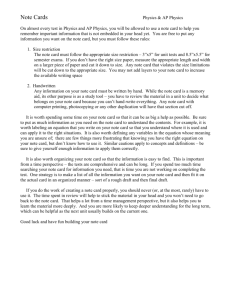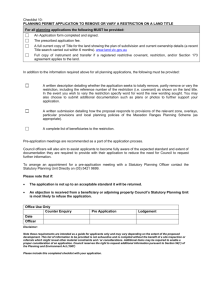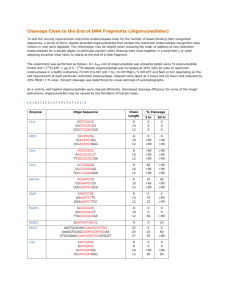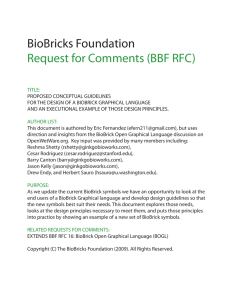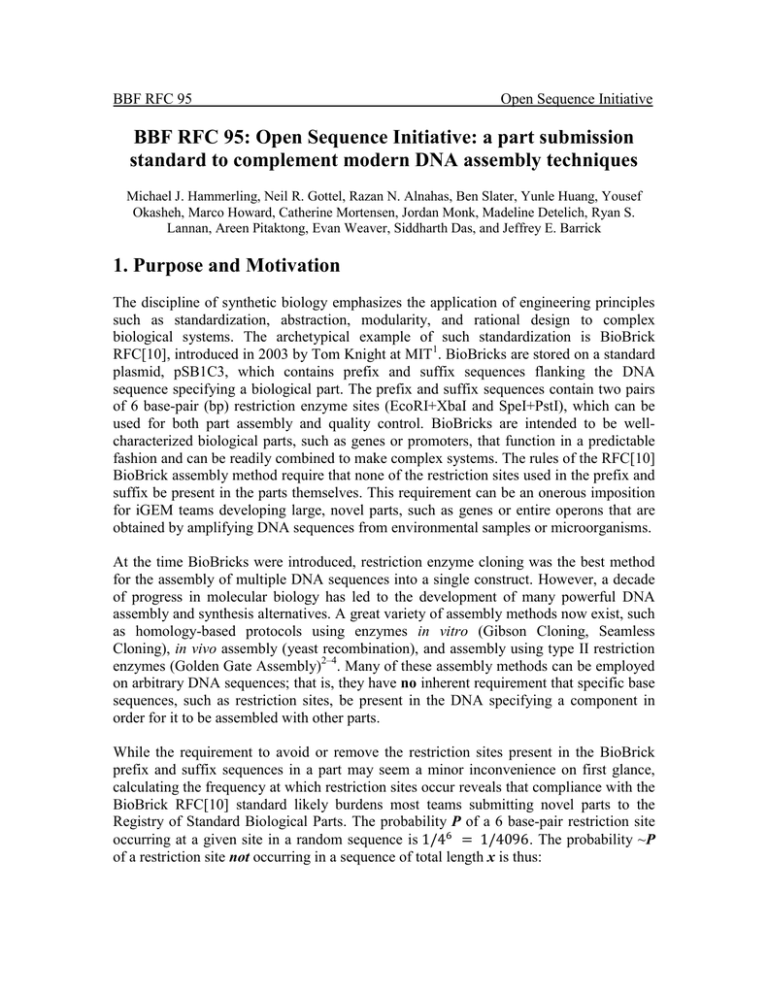
BBF RFC 95
Open Sequence Initiative
BBF RFC 95: Open Sequence Initiative: a part submission
standard to complement modern DNA assembly techniques
Michael J. Hammerling, Neil R. Gottel, Razan N. Alnahas, Ben Slater, Yunle Huang, Yousef
Okasheh, Marco Howard, Catherine Mortensen, Jordan Monk, Madeline Detelich, Ryan S.
Lannan, Areen Pitaktong, Evan Weaver, Siddharth Das, and Jeffrey E. Barrick
1. Purpose and Motivation
The discipline of synthetic biology emphasizes the application of engineering principles
such as standardization, abstraction, modularity, and rational design to complex
biological systems. The archetypical example of such standardization is BioBrick
RFC[10], introduced in 2003 by Tom Knight at MIT1. BioBricks are stored on a standard
plasmid, pSB1C3, which contains prefix and suffix sequences flanking the DNA
sequence specifying a biological part. The prefix and suffix sequences contain two pairs
of 6 base-pair (bp) restriction enzyme sites (EcoRI+XbaI and SpeI+PstI), which can be
used for both part assembly and quality control. BioBricks are intended to be wellcharacterized biological parts, such as genes or promoters, that function in a predictable
fashion and can be readily combined to make complex systems. The rules of the RFC[10]
BioBrick assembly method require that none of the restriction sites used in the prefix and
suffix be present in the parts themselves. This requirement can be an onerous imposition
for iGEM teams developing large, novel parts, such as genes or entire operons that are
obtained by amplifying DNA sequences from environmental samples or microorganisms.
At the time BioBricks were introduced, restriction enzyme cloning was the best method
for the assembly of multiple DNA sequences into a single construct. However, a decade
of progress in molecular biology has led to the development of many powerful DNA
assembly and synthesis alternatives. A great variety of assembly methods now exist, such
as homology-based protocols using enzymes in vitro (Gibson Cloning, Seamless
Cloning), in vivo assembly (yeast recombination), and assembly using type II restriction
enzymes (Golden Gate Assembly)2–4. Many of these assembly methods can be employed
on arbitrary DNA sequences; that is, they have no inherent requirement that specific base
sequences, such as restriction sites, be present in the DNA specifying a component in
order for it to be assembled with other parts.
While the requirement to avoid or remove the restriction sites present in the BioBrick
prefix and suffix sequences in a part may seem a minor inconvenience on first glance,
calculating the frequency at which restriction sites occur reveals that compliance with the
BioBrick RFC[10] standard likely burdens most teams submitting novel parts to the
Registry of Standard Biological Parts. The probability P of a 6 base-pair restriction site
occurring at a given site in a random sequence is
. The probability ~P
of a restriction site not occurring in a sequence of total length x is thus:
=
For additional accuracy, the effect of average GC content can be taken into account, due
to the occurrence of only 2 G/Cs in the recognition sites of EcoRI, XbaI, and SpeI, and 4
G/Cs in the PstI site. This bias results in the four restriction sites occurring more often in
AT-rich sequences. The probability of a site occurring in a sequence of length x is:
Where a and b are the probabilities of A/Ts and G/Cs occurring at a known GC%, while y
and z are the number of A/T and G/C nucleotides in a given restriction site. As an
example, the ~P for EcoRI (GAATTC) in a region with 60% GC content is:
From this equation, the probability Q of none of the four "illegal" restriction sites
appearing in a sequence of length x can be determined:
Graphing the probability of at least one of the four restriction sites appearing in a
sequence of a given length (Fig. 1) makes the problem clear:
Fig. 1: The probability of at least one example of one the four BioBrick restriction sites appearing in
random DNA sequences of different lengths. The lengths at which sequences will have a 50% and
90% likelihood of containing an illegal site are highlighted for the 50% GC-content line.
The probability of a random part containing at least one example of one of the four
restriction sites rapidly increases with sequence length, such that a majority of parts >710
bp will contain a BioBrick restriction site, and more than 90% of those >2360 bp will.
Given that the length of a typical bacterial protein open reading frame is roughly 1000 bp,
an iGEM team would be lucky to find a novel or naturally occurring gene-sized part, let
alone an operon, that did not contain an illegal restriction site.
While iGEM teams may use methods such as site-directed mutagenesis to remove illegal
restriction sites from a part's sequence, it is certainly possible that this mutation will alter
the functionality of the part – a very undesirable outcome. In addition, the mutagenesis of
illegal restriction sites is an unnecessary burden on teams, given the limited time and
resources available to teams during each year’s iGEM competition. Efforts spent
mutagenizing sites would be better spent characterizing and improving parts. This RFC
proposes an alternative submission standard to eliminate these problems.
2. Relation to other BBF RFCs
This RFC is intended as an alternative or a replacement to the current Biobrick standard
RFC[10] in order to reduce restrictions on parts submitted to the Registry of Standard
Biological Parts. Crucially, this RFC removes the sequence restrictions imposed by
RFC[10] regarding the removal of the restriction enzymes sites EcoRI, XbaI, SpeI, and
PstI from parts before they are eligible for inclusion in the Parts Registry.
3. Copyright Notice
Copyright (C) The BioBricks Foundation (2013). All Rights Reserved.
4. The Open Sequence Format and Quality Control
Quality control is critical for any serious engineering endeavor. While teams SHOULD
sequence verify their parts to detect point mutations and small indels, the BioBricks
Foundation needs a simple and rapid method for determining that parts are at least the
correct size when submitted to The Registry. Currently this quality control is achieved
through the use of the restriction sites present in the BioBrick prefix and suffix
sequences, resulting in restrictive rules for part submission. Therefore, we propose the
Open Sequence Format (OSF), featuring an alternative submission plasmid, pSB1C95,
containing the homing endonuclease sites I-SceI and I-CeuI for quality control purposes.
Parts MUST be submitted between the BioBrick prefix and the BioBrick suffix that are
present in the pSB1C95 backbone, and the homing endonuclease sites I-SceI and I-CeuI
MUST NOT be contained within the part itself (Fig. 2A). There are no other rules or
restrictions for part submission. Note that, if a part that does not contain internal BioBrick
restriction sites is cloned into pSB1C95 it remains compatible with RFC[10] assembly;
otherwise it must be combined with other parts using other assembly methods.
A
B
Fig. 2: (A) Order of BioBrick prefix, suffix, and homing endonuclease sites on the RFC[95] standard
submission plasmid pSB1C95 . The rest of the pSB1C3-derived backbone remains the same. (B)
Recognition sequences and corresponding cut sites of the homing endonucleases I-SceI and I-CeuI5.
Unlike typical 6 bp restriction sites, the I-SceI and I-CeuI homing endonuclease sites are
18 bp and 27 bp in length (Fig. 2B), respectively. Sites with some base substitutions from
the canonical recognition sequences are still cut, so the overall sequence degeneracy of
these sites is roughly equivalent to that of a normal 10 to 12 bp restriction site5,6.
However, the probability of even a 10 bp sequence randomly occurring in a submitted
part is orders of magnitude lower than a 6 bp site, effectively eliminating the problem of
illegal sites for the purposes of rapid quality control on gene- and operon-sized parts.
Fig. 3: Comparison between the probability of the occurrence of homing endonuclease sites RFC[95]
and the current BioBrick RFC[10] restriction sites in a sequence of a given length.
I-SceI and I-CeuI are both available from New England Biolabs, and function at 100%
efficiency in NEB Cutsmart™ buffer. Since quality control at iGEM headquarters
consists primarily of cutting each part out of the plasmid with restriction enzymes and
matching observed fragment size to expected fragment size, all other aspects of the
quality control process would remain unaltered, drastically reducing the probability of
illegal sites or erroneous restriction analysis results while preserving the majority of the
present quality control workflow, while supporting modern assembly methods.
5. Example Assembly Method
This RFC decouples the assembly standard proposed by RFC[10] from the submission
standards currently used by the Parts Registry. Modern assembly methods require less
time, can combine many parts at once, work well with novel parts, and leave no scar. One
such method, Gibson assembly, can combine multiple genes or gene fragments in the
desired order in a one-hour, one-pot reaction2,7.
This process can be used to submit parts compatible with the RFC[95] submission
standard by designing overlap regions between the part to be submitted and the plasmid
backbone that includes the SceI and CeuI sites. Examples of primers to amplify parts are
shown below:
Forward Part Primer
Reverse Part Primer
Fig. 4: A 58 bp forward primer used to amplify a part in preparation for Gibson assembly using the
plasmid pSB1C95, and the corresponding 58 bp reverse primer. Note that only part of the I-CeuI
homing endonuclease site is needed to achieve a homology region of sufficient length.
Using a reverse primer to the Biobrick prefix, and a forward primer to the Biobrick
suffix, teams may produce a linear plasmid backbone fragment. Per design of the part
amplification primers, this backbone will share ~40 bp of sequence identity with the
amplified part. Many DNA fragments may easily be assembled by introducing sequence
overlap in the order in which they are to be assembled, allowing the rapid assembly of
many parts into the plasmid backbone in one Gibson cloning reaction.
6. Conclusion
Maintaining a genetic part repository is an inherently labor-intensive and error-prone
process, but one that supplies a valuable service to both veteran and novice research
groups. It is important to employ strategies that enable simple quality control workflows
and maximize utility to the end user. We believe that allowing part submission in the
Open Sequence Format will eliminate user problems associated with sequence
restrictions while minimally impacting quality control workflows at the repository.
Author’s Contact Information
Michael J. Hammerling
Neil R. Gottel
Jeffrey E. Barrick
mhammerling@gmail.com
neil.gottel@utexas.edu
jbarrick@cm.utexas.edu
References
1.
Knight, T. Idempotent Vector Design for Standard Assembly of Biobricks
Idempotent Vector Design for Standard Assembly of Biobricks. Retrieved from
<http://hdl.handle.net/1721.1/21168> (2003).
2.
Gibson, D. G. Enzymatic assembly of overlapping DNA fragments. Methods
Enzymol. 498, 349–61 (2011).
3.
Gibson, D. G. Synthesis of DNA fragments in yeast by one-step assembly of
overlapping oligonucleotides. Nucleic Acids Res. 37, 6984–90 (2009).
4.
Engler, C., Kandzia, R. & Marillonnet, S. A one pot, one step, precision cloning
method with high throughput capability. PloS ONE 3, e3647 (2008).
5.
Geneious version 6.06 created by Biomatters. Available from
http://www.geneious.com/
6.
NEB: Homing Endonucleases. Retrieved from
<https://www.neb.com/products/restriction-endonucleases/hf-nicking-master-mixtime-saver-other/homing-endonucleases/homing-endonucleases> (2013).
7.
Belfort, M. & Roberts, R. J. Homing endonucleases: keeping the house in order.
Nucleic Acids Res. 25, 3379–88 (1997).
8.
Collins, B. et al. BBF RFC 57 : Assembly of BioBricks by the Gibson Method.
Retrieved from <
.synbio.org.u gibson do nloads files RFC57.pdf> (2010).

